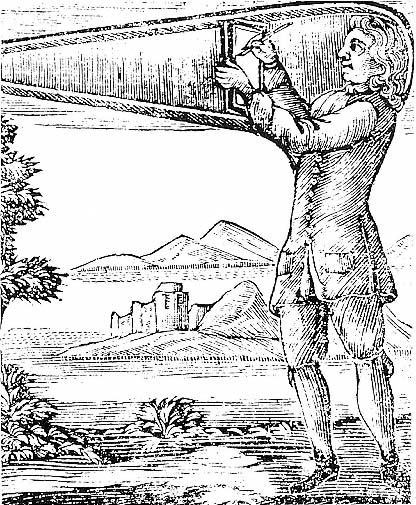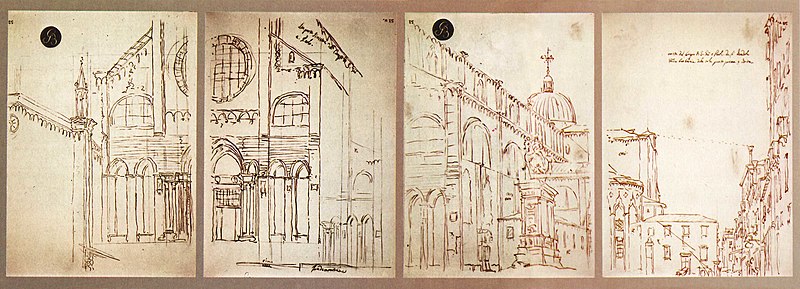|
An artist drawing a seated man onto a plane of glass through a sight-vane, from the fourth book of Albrecht Dürer’s Four Books on Measurement.
|
Last month, a number of people sent me Vanity Fair’s pieceon engineer Tim Jenison’s painstakingly-complex recreation of Johannes Vermeer’s The Music Lesson. Jenison faithfully built the room and objects depicted in the painting, and then repainted the scene using a version of a camera obscura. In the end, he discovered what any freshman art history student could have told him: yes, it’s possible that Vermeer used a camera obscura. He’d have hardly been alone.
 |
|
Sir Robert Hooke’s portable drawing machine should be familiar (in concept) to any of my plein air painting students. There is nothing new under the sun.
|
The peculiar properties of the pinhole camera were known and described in antiquity from Greece to China. In the west, the principles behind it were analyzed and described by the eleventh century Arab scientist, Ibn al-Haytham. In the 13th century, Roger Bacon described the use of a camera obscura to watch solar eclipses. Leonardo da Vinci puttered with one, and even came up with a proto-telescope based on it:
…in order to observe the nature of the planets, open the roof and bring the image of a single planet onto the base of a concave mirror. The image of the planet reflected by the base will show the surface of the planet much magnified.
Filippo Brunelleschi (1377-1446), sculptor, architect, artist and engineer, is generally (and perhaps falsely) credited with the invention of linear perspective in art. He also created a device to demonstrate that perspective, which we call Brunelleschi’s peepshow, but which is in fact a version of a camera obscura:
“[He] had made a hole in the panel on which there was this painting; … which hole was as small as a lentil on the painting side of the panel, and on the back it opened pyramidally, like a woman’s straw hat, to the size of a ducat or a little more. And he wished the eye to be placed at the back, where it was large, by whoever had it to see, with the one hand bringing it close to the eye, and with the other holding a mirror opposite, so that there the painting came to be reflected back; … which on being seen, … it seemed as if the real thing was seen: I have had the painting in my hand and have seen it many times in these days, so I can give testimony. (Antonio di Tuccio Manetti)
|
A Man Drawing a Lute, from the fourth book of Albrecht Dürer’s Four Books on Measurement.
|
Albrecht Dürer was not a visionary in the manner of Leonardo, but he was peerless in investigating and recording his experiments. Several woodcuts of drawing aids come down to us from him, so we know he used them. Nevertheless, using a camera obscurawas not the only thing he could do; the man could draw brilliantly. Very few living artists today could duplicate his Young Hare or Large Piece of Turf, neither of which relied on optical tools.
 |
|
Courtyard of the Former Castle in Innsbruck without Clouds, 1494, Albrecht Durer. Was it done with a drawing device? Perhaps. Does that make it less brilliant? I don’t think so.
|
Ultimately, it doesn’t matter whether Vermeer used an optical device. That’s the one thing Tim Jenison’s experiment proves. It’s ultimately nothing more than a fair copy of a masterpiece, such as art students churn out every day. Vermeer’s incalculable genius is safely his own.
 |
| Artists used the camera obscura until the development of photography made it obsolete. Here are four camera obscura drawings by Canaletto from the early 18th century. |
Let me know if you’re interested in painting with me in Maine in 2014 or Rochester at any time. Click here for more information on my Maine workshops!

Nice post today, my feelings exactly! Thanks for the insite and research! Matt
Not so much research as that I'm fanatic about Durer and have several collections of his woodcuts. (Copies, alas, because if they were original I might have an entirely different life.) And every time someone gets on the Vermeer-camera obscura rant I drag those beautiful woodcuts of his out.
Robert Hooke's viewfinder looks less like a camera obscura than the same kind of viewfinder plein air artists use today, except of course that he didn't have access to dry erase markers. He was an interesting man, another of those Age of Reason polymaths that put us all to shame.